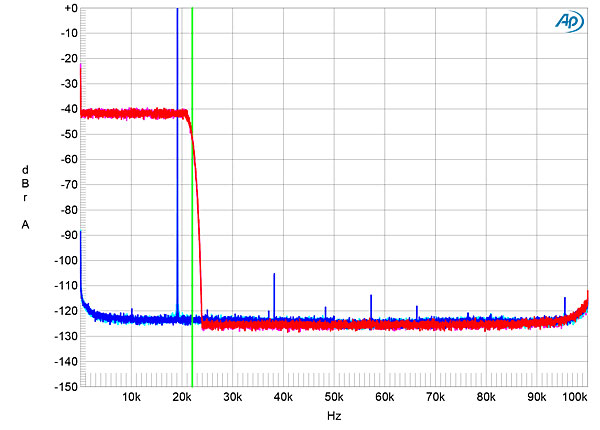In Amir's dashboard the level for D400ES is about 4.2Vrms at 1kHz. If you use a built-in filter with the flattest frequency response (linear phase fast roll off) then this voltage should not significantly change within 20Hz to 20kHz. In another D400EX dashboard I also saw a similar Vrms value on the dashboard.Thanks for the detailed post. I tried with Audirvana studio, I did upsampling PCM files (with MQA nothing can be done). With upsampling, when one of the filters on DAC is ON, the sound is very similar, but when the filter is OFF, the volume is reduced and there is no clipping. The sound is roughly the same as with the filter ON. I noticed in the review of the D400EX model that all filters up to about 10KHz go around 0 dB, as is normal. Only about 17Khz (and only one filter) reduces it to -4.25dB. With the D400ES, all filters reduce the volume from 0Hz by -4.25Hz. It doesn't make any sense.
The frequency response and filter plots are labeled as dBrA, which is a relative value. You can read in this post:

Topping D90 Balanced USB DAC Review
Now a site known for its subjective reviews is using ASR as reference. .https://audiobacon.net/2019/12/24/topping-d50s-dac-review/ These guys write the same words when a DAC measures great and doesn't cost a lot. It is sterile, not coherent, etc., etc. I don't know how it is that...
 www.audiosciencereview.com
www.audiosciencereview.com
As a matter of fact, the ES model is based on ESS and EX model is AKM, and they are not doing exactly the same thing in the context of bypassing filters and the audio level after bypass the filter, what's important is both models are measured as 4.2Vrms at analog output when the filter is not bypassed. If you want to verify this you can record the analog output of both DACs with the flattest built-in filter (Sharp roll-off in the case of AKM) and compare the level of the recorded signal and see if one of them is really several dB lower than the other or not. I attached a test signal in the post below so you can try it out, read the posts before and after it to know what the topic is about:

RMAA Tests: (Welcome to add others!)
You need levels to remain the same for all devices to be able to compare. i did a bunch of these today, feeding from my rme adi2 pro fs and topping D70 at high (+24 dBU), mid (-2 dBU) and low levels (-14 dBU), to get a sense of preamp quality on those that have gain stages. a few were loopbacks...
 www.audiosciencereview.com
www.audiosciencereview.com
For example, in this post you can see member KSTR complained that the AK4490 is doing 8x upsampling with 44/48k input, but only 2x upsampling with 192k input, also a screenshot indicating clipping. It may not be the case when using AK4191+AK4499EX, but a perfect example that different products upsample differently, when something is bypassed they also behave differently.

Digital filter "game"
Some of you probably have seen a lot of filter plots like these on DAC datasheets: How about making these things without using specialized software like Matlab, Octave and such? They are not particularly easy to use. So many people just "see" them rather than try to figure out the meaning...
 www.audiosciencereview.com
www.audiosciencereview.com
In short, if the output voltage of both DACs are similar when the flattest built-in filter is not bypassed, then both DACs are working fine. Any level discrepancies in the case of bypassing filters are inherent to the internal structures of individual products.




